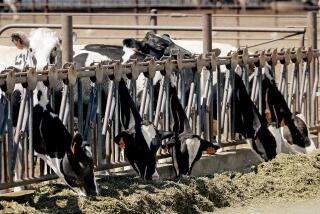Why your Super Bowl vegetable platter might cost more this year
Produce seller Rich Uchida is sitting pretty for the Super Bowl right about now. Because it turns out California not only has the 50th edition of the game, it has the Buffalo wings and veggie platters cornered, too.
Uchida’s employer, Duda Farm Fresh Foods, is the king of celery sticks, and isn’t into cauliflower much.
In an industry where timing is everything, both of those positions are important, because it’s been a wild season in the winter produce market dominated by California growers, who are responsible for upwards of 90% of the country’s supply of many winter vegetables.
Drought followed by the rains of El Niño, and heat followed by cold snaps created a cauliflower price boom that now has turned to a bust, and a celery inflation that lingered just long enough, growers and industry experts say.
Carrots, broccoli, lettuce, green onions, and even strawberries have suffered from price swings as well.
“Produce always revolves around weather, so when weather hits extremes, produce hits extremes,” said Stephanie Williams Blanton, vice president of procurement for Produce Alliance LLC, a food service management company that publishes a closely watched weekly industry newsletter.
“All those major commodities were affected because they can’t withstand extreme weather,” Blanton said. Then, when growers moved from the Salinas Valley down to desert regions, a cold snap hit there, she said.
Many crops were delayed for as much as five weeks and yields dropped, leaving a supply gap.
Cauliflower, the darling of the low-carb set, garnered headlines as panicked dieters complained of shortages and high prices.
Wholesale cases of cauliflower rose to an unheard-of $50 in the late fall. In Canada, that and a sagging exchange rate driven by plummeting oil prices pushed consumer prices toward $10 a head.
Lately, though, the whole box of cauliflower goes for about $9, said Brian Antle, vice president of harvest for Tanimura & Antle, based in Salinas. “I was right in the middle of the cauliflower shortage since late fall and pulling my hair out to satisfy demand but that story is old news now,” Antle said.
“It’s at the bottom,” said John Scherpinski, director of sales for Salinas-based D’Arrigo Brothers, the biggest row-crop grower west of the Mississippi. D’Arrigo couldn’t capitalize on the cauliflower boom because it sells largely by contracts signed before the market ran wild.
D’Arrigo also is not into celery, the poster child for this winter’s vegetable market fluctuations. But Duda grows it in California and three others states: Florida, Arizona and Michigan.
“Basically, the celery came on too fast,” in early growing areas such as Ventura County, said Uchida, western regional manager for Duda. Then, just like the cauliflower, growth slowed as cold weather hit.
The crop is still lagging by two weeks, though the shortage is largely over and prices are starting to fall, Uchida said.
Once selling at $38 a box to wholesale buyers, celery hovers around $18 to $22 “and it’s still headed down,” he said. Retail prices peaked at $1.81 a pound two weeks ago, before settling to $1.72 last week, more than double last year’s prices, according to the U.S. Department of Agriculture.
Jumbo carrots in California’s Cuyama Valley have suffered low yields, driving up prices as well, according to Produce Alliance.
Prices for the more common veggie plate variation, the milled and shaped “baby” carrots, are back at peaks hit in November, when demand for many of these holiday dish ingredients usually rises, according to USDA data.
Prices for broccoli, another veggie plate occupant, have come down substantially from a high near $3 a bunch in the second week of December, according to the USDA.
“It’s leveling out right now,” Blanton said of produce prices across the board. “The desert has seen warmer days for a couple of weeks. That’s why produce is getting better. Broccoli, cauliflower, we gave it more time to stay in the ground and mature.”
Duda stayed away from the cauliflower fad and stuck with celery in all forms, supplying soup makers and supermarkets alike. But its sticks, processed in Oxnard, are sold to all the major restaurant chains — Uchida wouldn’t reveal which ones, but if you’re ordering Buffalo wings just about anywhere, chances are you’ll get a side dish of Duda’s sticks.
See more of our top stories on Facebook >>
“We’re busy with that particular item starting the holiday season, as everyone starts having holiday parties,” Uchida said. “We see an increase in business because of the holiday season, a little lull the first two weeks of January, then it picks up around the Super Bowl.”
Avocados, that other Super Bowl party staple, didn’t suffer the same fate as winter vegetables, according to the Hass Avocado Board. It predicted fans will scarf up 139 million pounds of the stuff during Super Bowl weekend. But the vast majority of it will be from Mexico.
MORE FROM BUSINESS
Lazarus: Martin Shkreli isn’t alone in ripping off patients with crazy drug prices
Review: 2016 Prius Four is a smarter, sleeker version of Toyota’s aging hybrid
Hiltzik: How a huge insurance company screwed up on Obamacare
More to Read
Inside the business of entertainment
The Wide Shot brings you news, analysis and insights on everything from streaming wars to production — and what it all means for the future.
You may occasionally receive promotional content from the Los Angeles Times.











